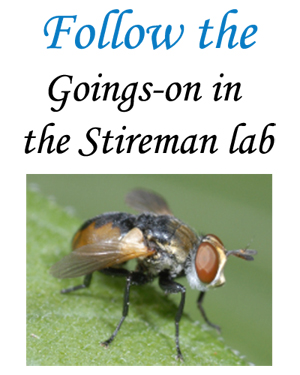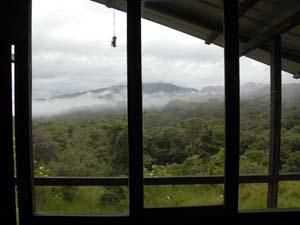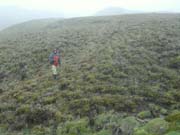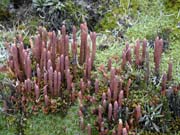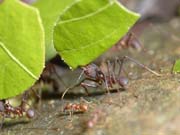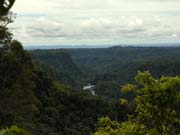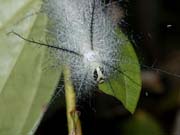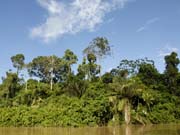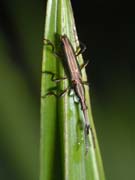In December 2012 I traveled to Ecuador with a graduate student, Karen Pedersen. While there I joined up with a number of old graduate school friends (including Harold Greeney, Matt Kaplan, and Caleb Gordon) to travel to a number of sites in North-Central Ecuador (see my lab website for a more general overview of this trip). Although there were several objectives of this trip (e.g., getting Karen set up to begin her study of the ecology of Altinote butterflies), one of my major goals was to collect tachinids for our Phylogeny of World Tachinidae Project.
Given our poor knowledge of tachinids in Ecuador, I was not targeting any particular taxa, but rather trying to collect representatives of a diverse array of taxa. To this end, I visited a variety of sites on the eastern side of the Andes, ranging from over 4000 meters around Papallacta Pass to nearly 200 meters in elevation in the Amazonian lowlands.
Unfortunately, I failed to record all of the tachinid specimens that were collected at each site before they were distributed throughout my collection housed at Wright State University, and thus I am unable to list all of the taxa collected. However, all specimens from which legs were taken for potential DNA sequencing were recorded, and these are listed here. Many of the generic identifications are preliminary, pending comparison with reliably identified material in the US NMNH, the CNC or other major collections. Likewise, identification to species is hampered by the many undescribed taxa and lack of specimens for comparison of those taxa that have been described.
My aim here is to do the following:
- Mention the localities where tachinids were collected,
- list the taxa collected for DNA (i.e., legs removed for potential sequencing),
- mention some of the additional taxa encountered, and
- include a few images of the localities visited and associated organisms.
Note that generally Wood & Zumbado’s (2010) rather broad generic concepts are used here, although currently valid Townsend generic names (Guimaraes 1971) are indicated where species are indicated. There is uncertainty in many of the generic identifications; this is often indicated by question marks. Also, it is not clear for many specimens if they belong to a particular genus or a similar, closely related genus, and this is indicated by “Genus nr.”
Localities and species arranged by site
Yanayacu
Ecuador, Napo Prov., Yanayacu Biological Station, 00°36'S, 77°53'W, 2163 m, 19-21, 23.xii.2012
Yanayacu Biological Station is a small field station that was built by my longtime friend and colleague Harold Greeney. This station has been the epicenter of the Caterpillars and Parasitoids of the Ecuadorean Andes (CAPEA) project spearheaded by Lee Dyer (U, Nevada, Reno) that I have been involved with for about ten years. Located just west of the town of Cosanga, Yanayacu is on the eastern slope of the Andes mountains. The habitat is montane tropical forest (essentially cloud forest), with some pasture and marshy areas. As I have noted previously, it is a fantastic area for tachinids, particularly Tachinini (e.g., Epalpus, Adejeania, and related genera) and Blondeliini (e.g., Calolydella, Lixophaga, Leptostylum). In terms of sheer tachinid abundance and ease of collecting (along trails and roadsides) it is difficult to beat the mid-elevation tropical Andes.
In addition to hand collecting, my student Karen was able to run a small Malaise trap for several months behind the station at Yanayacu. We are just beginning to sort this material, but we will update this page with our results from this trap when sorting and preliminary identification are complete.
Specimens preserved for DNA
Anoxynops sp.
Calolydella sp. 1
Calolydella sp. 2
Campylocheta sp.
Chrysoexorista sp.
Cyrtophleba sp.
Daetalus/Scotiptera sp.
Epalpus sp.
1
Epalpus sp. 2
Epalpus sp. 3
Epiphanocera (c.f.) sp.
Genus nr. Neobrachelia sp. (2)
Genus nr. Polygaster sp.
Hypoproxynops sp.(2)
Italispidea n. sp.
Italispidea sp. 1 (2)
Italispidea sp.
2
Leschenaultia sp.
Lixophaga (Actinotachina) sp.
Lixophaga sp.
2
Megaprosopus sp.
Myiopharus n. sp. (2)
Neomintho sp. nr. macilenta (Wiedemann)
Parepalpus sp.
Patelloa (Chaetophorocera) andina Tnsd
Phyllophilopsis sp. 1 (3)
Phyllophilopsis sp. 2
Quadratosoma "rufum" (?) Tnsd.
Thelairodes sp.
unknown Blondeliini #1
unknown Blondeliini #2
unknown Blondeliini #3
Vibrissina (?) sp.
Vibrissina sp. 2
Winthemia sp.
Papallaca Pass
Ecuador, Napo Prov., Papallacta Pass, 0°19'S, 77°11'W, 4100-4300 m, 20.xii.2012
To travel from Quito (the capital of Ecuador), which lies in an inter-Andean valley at about 2800m, to the Amazonian region east of the Andes, one has to cross over Papallacta pass which rises to over 4000m in elevation. At the top of the pass one can reach even higher elevations by driving up a dirt road to a radio antenna. Our group spent a single day in this area of small lakes and high elevation “paramo” (tropical alpine tundra) vegetation. The flora was fascinating, with many low-growing clump forming perennial forbs, grasses, and lichens, reminiscent of the sponges and corals one might see on a sea-bottom. Unfortunately, most of the day it was cold, windy, and foggy as is typical of this habitat and relatively few flies were observed aside from crane flies. However, as my birding colleagues went off looking for Rufous-bellied Seed Snipes, I was able to collect a few tachinids off of the tops of shrubs during bouts of relatively nicer weather.
Specimens preserved for DNA
Pseudoviviania sp. (2)
Quadratosoma (Camposiana) emarginata Tnsd.
(Also collected were several specimens of a high elevation Admontia species.)
Jatun Sacha
Ecuador, Napo Prov., Jatun Sacha Reserve, 1°04'S, 77°36'W 450 m, 21.xii.2012
A group of us ventured ca. 25 km east of Tena, along the Rio Napo to a small (2200 ha) reserve and biological station known as Jatun Sacha. This reserve encompasses hilly lowland tropical forest at approximately 450 m. We spent the night in their cabanas and ventured on the trails and in surrounding areas on day and night walks. There is some very nice primary forest in the reserve and a good trail system. I did not have a permit to collect in the reserve itself, but I did a little bit of collecting in areas near the main road surrounding the reserve. I did not see many tachinids, but I was able to collect a few specimens perching on leaves, and one Ormia at a light at night.
Specimens preserved for DNA
Leskia (Urumyobia) aurata (or nr.)
Neomintho sp. nr. macilenta (Wiedemann)
Ormia nr. dominicana (Tnsd.)
El Bigal
Ecuador, Orellana Prov., El Bigal River Reserve, 0°31'S 77°23'W ca. 1000 m, 25-27.xii.2012
After returning to Yanayacu, the group rejoined and traveled east again on Loreto road to visit another small reserve in the Andean foothills called Bigal River Biological Reserve that adjoins the huge Sumaco National Park. To reach this reserve, we drove for about an hour northwest of Loreto on a dirt logging, and then, when the road became so muddy as to be impassable, we had to walk approximately five kilometers further, until reaching a short trail that then led to the main lodge. Luckily, our gear was carried by burros. This reserve, operated by two French caretakers, Marion Hiruois and Thierry Garcia, has some of the best looking, most diverse forest I have seen in Ecuador. Much of it seemed untouched and wild. Again, I did not have specific permission to collect in the reserve and it is difficult to collect many tachinids along forest trails in tropical wet forest anyway, so much of my collecting there was focused on the edge of the reserve along the old logging road. Unlike the higher elevations, I had to work harder to find tachinids, but I found that urinating on vegetation along the road side was a pretty good way to attract them. The tachinid fauna differed strongly from that found at the higher elevations around Yanayacu with a much smaller proportion of tachinines and many more Eryciine and Goniine taxa (or at least these seemed far more abundant).
Given the lack of refrigeration or other means to keep specimens from getting moldy, I collected the tachinids here directly into 50 mL tube with alcohol (95% ethanol, just in case they might be needed for DNA). I kept this tube in my pocket as I walked the trails and road, which turned out to be a mistake. The high proof ethanol made the specimens brittle, and as I hiked around they were jostled in the ethanol. After a day or two of this I noticed a sediment of tachinid setae forming at the bottom of the vial. Bristles from all over the body were being rubbed or broken off the specimens. Once I noticed this, I made sure to frequently transfer specimens to a tube that I did not carry around (except for the 5 K hike out and an hour on a bumpy dirt road), but the damage was done. Many of the specimens were almost completely devoid of setae when I later examined them, and others were missing legs or otherwise damaged. Most are of only limited value, if any. Lesson learned.
Specimens preserved for DNA (includes some other specimens, #L indicates number of specimens with legs taken for DNA).
Billaea sp.
Ebenia sp. (2)
Drino sp.
Lespesia sp. (1L)
Lixophaga (?) sp. 1 (1L)
Lixophaga (?) sp. 2 (1L)
Myiopharus sp. 1
Myiopharus sp. 2 (7, 3L)
Phyllophilopsis sp.
I also collected additional specimens of Leschenaultia, Blepharipa, Drino, Carcelia, and Atacta/Atactosturmia. The fauna, at least with hand netting from low vegetation, was dominated by Goniini, Eryciini, and Blondeliini (most commonly Myiopharus and Lixophaga).
Shiripuno
Ecuador, Orellana Prov., Shiripuno Lodge, Shiripuno River. 01°06'S 76°44'W ca. 230 m, 28-29.xii.2012
Our last trip in Ecuador was down to the “real” Amazonian lowlands (ca. 200 m in elevation). From the town of Coca in Orellana province, we drove down the Auca road until we reached a small winding river, Rio Shiripuno. Then we loaded into canoes for a four hour trip down (East) the river to a fantastic place called Shiripuno Lodge. This lodge is located on the Huaorani Reserve and is quite close to the “intangible zone,” where there are people living that have little or no contact with modern civilization. It is also not far from areas in and around Yasuni National Park now being opened up for oil exploration. However, these threats seem distant when one is at Shiripuno with what seems like endless forest in all directions, filled with parrots, toucans, and monkeys. As mentioned previously, collecting tachinids in lowland tropical rainforest is not an easy task. Most of them are probably high up in the multi-layered tree canopies. The best way to hunt tachinids is to find a sunny edge of some sort (edge of a clearing, stream bank) and look for them in prominent spots. I sprayed a Coca Cola in some of these areas, and, again, found that peeing on sunlit vegetation was a profitable way of attracting tachinids.
Again, I had to collect into alcohol to preserve specimens, but, learning from my experience at El Bigal, I made sure to minimize the “jostling” of specimens so that they fared much better in terms of retaining setae. Most specimens from this site were not yet dispersed in my collection, so the list below is more complete than the previous lists, and includes specimens that I did not take legs from (#L indicates the number of specimens that I took legs from).
Specimens preserved for DNA
Aplomyiopsis (?) sp. (2, 1L)
Archytas (Genus nr.) sp.
Archytas sp. (2)
Argyrophylax (?) sp.
Atacta sp. (8, 2L) - possibly > 1 species
Atactosturmia (Genus nr.) sp.
Atactosturmia sp. 2 (1L)
Atactosturmia sp. 3 (2, 1L)
Atatosturmia/Blepharipa?
Belvosia sp. 1 (2) – possibly > 1 species
Belvosia sp. 2
Belvosia sp. 3 (3, 1L)
Billaea sp. (2L)
Blepharipa sp. 1 (5)
Blepharipa sp. 2
Blepharipa sp. 3
Borgmeiermyia (Genus nr.) sp. (1L)
Calodexia sp. 1
Calodexia sp. 2
Carcelia sp. 1 (2)
Carcelia sp. 2
Casahuiria (?) sp. (2, 1L)
Chaetogaedia (or Genus nr.) sp. (1L)
Chrysotachina sp. (1L)
Dolichocodia (?) sp.
Drino (or Lydella?) sp. (1L)
Drino sp. 1 (6)
Drino sp. 2 (3, 2L)
Drino sp. 3
Drino sp. 4
Drino sp. 5 (1L)
Eribella (?) sp.
Eryciini (Genus unknown) (1 L)
Eucelatoria sp. 1 (3)
Houghia sp. 1 (1L)
Houghia sp. 2
Houghia sp. 3
Hyphantrophaga (or Genus nr.) sp. (1L)
Hyphantrophaga sp.
Hypotachina (Nemoraea?) sp. (1L)
Hypotachina chrysophora (?) (Wiedemann)
Ischyrophaga sp.
Leskia sp. (1L)
Lespesia sp. 1 (1L)
Lespesia sp. 2 (2)
Linnaemyia (Genus nr.) sp.
Lixophaga (?) sp. 1
Lixophaga (?) sp. 2
Myiopharus sp. (12, 1L)
Neomintho sp. 1 (2)
Neomintho sp. 2 (2, 2L)
Phyllophilopsis sp. 1 (1L)
Phyllophilopsis sp. 2
Phyllophilopsis sp. 3
Phyllophilopsis sp. 4 (1L)
Phyllophilopsis sp. 5
Telothyria sp. 1
Telothyria sp. 2
Winthemia sp. 1 (2)
Winthemia sp. 2 (1L)
Winthemia sp. 3 (2L)
In addition to tachinids, I collected several Mesembrinella (Calliphoridae) specimens as well as a number of Sarcophagidae.
References
Guimarães, J.H. 1971. Family Tachinidae (Larvaevoridae). A catalogue of the Diptera of the Americas south of the United States 104: 333 pp.
Wood, D.M. and Zumbado, M.A. 2010. Tachinidae (tachinid flies, parasitic flies). Pp. 1343–1417. In: Brown, B.V., Borkent, A., Cumming, J.M., Wood, D.M., Woodley, N.E. and Zumbado, M.A., eds., Manual of Central American Diptera. Volume 2. NRC Research Press, Ottawa. xvi + 715–1442 pp.

